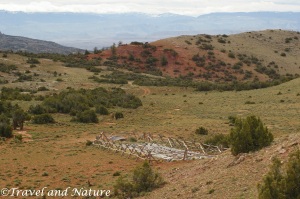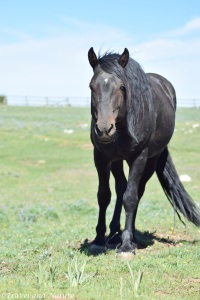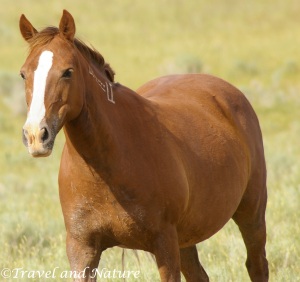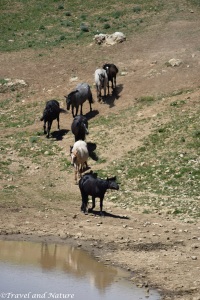A few weeks ago, I saw this article, and frankly ignored it hoping it would go away. Although it’s nice to hear that there’s at least one judge willing to listen, I’m not convinced that the ruling is in the best interest of the horses. True, I hate to see horses removed, but there’s no denying the range is in poor shape this year. In June, the levels at Mystic pond were more similar to September. The range has had a little moisture since then, but reports are it’s still dusty and dry. There is not enough summer grazing to support the horses that use the subalpine meadows of the mountain top.
I don’t think this will be as big a victory as people want it to be. Legally the Billings BLM should update their AML, but I don’t think the number they end up with will be a benefit to the horses. The idea that there is not enough seasonal grazing has been a long time coming. I don’t anticipate the BLM raising AML, and wouldn’t be surprised if they lower it. Not because they are trying to zero out the herd in the Pryors, rather, that might be the amount summer grazing has deteriorated. Either way, the only thing the lawsuit did was delay removals.
I still think litigation is a waste of time and money, and I don’t anticipate that changing anytime soon. I know I’ve mentioned it before, but the best way to work with the BLM is to compromise with them. In order to compromise with someone, they have to know their audience. The Billings BLM has been one of the first field offices to be open to adaptive management, so I think that will be the best approach for advocates. The BLM has already used some guzzlers to make improvements, so I think that will be a good starting point for people.

Most of the guzzlers have been very effective, but there is one on the mountain top that rarely gets used, if ever. Since there’s only two ponds at the top of the Pryors, it would be nice if some of the other underutilized meadows got more traffic, but the first step is figuring out why the existing guzzler isn’t being used. I don’t exactly know the answer to that question, but my best guess is the horses don’t know it’s there. The next step is to figure out a way for them to find out about it, but I don’t think there’s a really great way to do it. Occasionally a bachelor or two will head toward the meadow, so maybe all we have to do is wait for more bands to figure it out.
Most people know that there is a fence separating BLM land from USFS land. For a while some advocates wanted the entire removal of the fence, but recently they have been more willing to compromise. Rather than remove the fence entirely, advocates are proposing seasonal grazing of USFS land.

In theory, gates would open each fall letting the horses graze in the land adjacent to the range, then when snow pushed all the horses back on the range and down the mountain the gates would close. I want to like that compromise, but that doesn’t stop me from worrying about all the logistics involved. What happens if not all the horses make their way down the mountain? If there are few horses that want to stay on the FS side, will they be herded back? What if they still return to the FS side? I’m hopeful that a compromise can be made, but I also worry that if the horses don’t behave the way people think they will, it may give the USFS an opportunity to remove entire family bands like they did in 2009.

Ironically, the driest parts of the range seem to be around water sources. With the places where the horses roll, and well-worn horse trails it makes sense, but it might not be a bad idea to seed those areas. It would be a bit difficult for it to take, since the horses would still use the areas, but it would be better than nothing. Even if it takes a few tries to spread the seed, and have it fill in I think being proactive would save money in the long run rather than needing to remove as many horses. There’s also people who camp in the same spots each time they visit, and people who don’t always respect the need to stay on the road, so those spaces may need to be monitored for reseeding in the future too.

A fewish years ago the Billings BLM proposed prescribed burns in the Pryors that got turned down by advocates, and I worry that it may have been a missed opportunity. I understand people’s concern with the horses, and fire, but when the range is dry, it becomes a figurative tinder box. There was a confirmed lighting caused fire this summer, and considering how vast the range is, I wouldn’t be surprised if there have been more small fires caused by lightning. If the BLM was able to do a few controlled burns, they could time it to do different sections of the range different times of the year so they have less impact on horses and visitors. There will be less risk of large-scale fire due to lightning, and the resulting new growth will help rejuvenate the range.
At one point, the Billings BLM talked about the possibility of opening the administrative pastures in the Dryhead, but last I heard the challenge was making sure the area would be safe for the horses. The area is technically NPS land, so I think they were also waiting for them to make a decision. It wouldn’t cause a huge increase in AML, but if it works out it would be better than nothing.
I don’t anticipate there being an opportunity for the AML to be raised as much as advocates would like in the near future, nor do I think bait trapping will magically disappear after the recent lawsuit. However, I think advocates how much better the horses in the Pryors are being managed compared to other ranges. Even when it is outside the timeframe for public comment on scoping notices, and Environmental Assessments, the Billings BLM is still open for recommendations. They may not agree with everything, or plan on following the recommendations, but they listen. Lawsuits seem reactive to me, and that’s not going to help the horses. By working with the Billings BLM, advocates can be proactive, and make changes faster for the horses.
